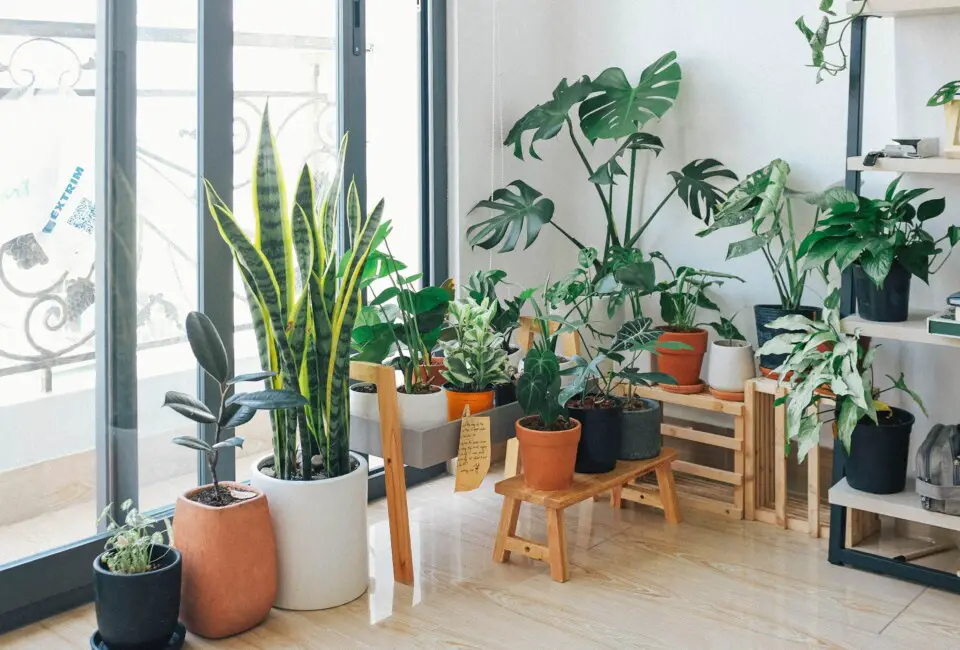Some links in the post are affiliate links and I get a commission from purchases made through some links found in the post.
Monsteras are some of the hardiest plants you can ever introduce to your home. As long as they have access to enough water, light, and nutrients, they will thrive and showcase their beautiful leaves.
However, if you neglect them or provide them with too much care (yes, that is a thing), they will start showing signs of distress.
Their leaves may be yellow; their growth may stunt, they may have holes on their leaves, develop small leaves, etc. These are all signs that all is not well with your monstera.
And often, it owes to a pest infestation brought about by the favorable conditions accruing from the neglect or too much love.
We look at some of the pests that can attack your monstera, how you can identify them, and most importantly, how you can get rid of them for good.
The most common pests you will find on your monstera are scale insects, spider mites, thrips and fungus gnats. A healthy monstera has a strong immune system and is usually not susceptible to pests but too much humidity, overwatering and lack of ventilation can cause conditions which are ideal for pests.
The 4 Most Common Monstera Pests
(Please note that viewing common monstera pests with the naked eye can often prove impossible. I advise you to get a magnifying glass to be more thorough with your inspection.)
I’ll start by saying that pests hardly ever make a home in a monstera or any other plant if the plant in question has all its needs met.
Usually, they creep in when there is a loophole, and I will explain this after I have covered the pests you should watch out for on your monstera and why. Without further ado, here we go:
Scale Insects
 Did you know that more than 1,000 species of scale insects exist in North America alone? That’s right. At any given point, your monstera is at risk of being infested by one of these species.
Did you know that more than 1,000 species of scale insects exist in North America alone? That’s right. At any given point, your monstera is at risk of being infested by one of these species.
These insects feed on your monstera sap and start as small infestations. Eventually, seeing as they are immobile, they grow in numbers, and you soon start seeing the results of their feeding.
The plant, which now has thousands of scale insects feeding on it, spends so much energy on healing the infested leaves that it forgoes the growth of more leaves.
It suffers stunted growth, and the remaining leaves take on a yellow hue as chlorosis begins.
If the monstera keeps growing under such conditions, it becomes quite weak and could die as the population of the scale insects becomes larger.
But how fast do these pests reproduce? The lifecycle starts with the adult female laying eggs that remain under a protective covering and hatch within the month.
The nymphs move away from the adult, and each finds a spot to which they can attach and feed on the monstera.
They use the sap in the plant to build their immunity and grow to the point of adulthood, and the cycle starts again.
Given the lack of a pupate stage, scale insects can produce concurrent nymphs each month, which helps them grow in numbers. Oh, and to make matters worse, the females can lay eggs without mating!
How Can You Identify Scale Insects?
When inspecting your plant, you should look for two types of scale insects.
The first, the armored scale insects, have a hard covering on their bodies. However, this covering is not attached to their bodies as it results from secretion from the insects.
The scale insects use it as a cover and lie under it as they feed on the monstera. These scale insects do not secrete honeydew, nor do they move on the plant. So, your focus should be on immobile pests with hard coverings.
The second kind has a soft surface that appears waxy. You can differentiate it from the first as it secretes a lot of honeydew and moves, unlike the first kind.
How Can You Control Scale Insects?
We’ve established that these pesky insects can cause much damage and kill your monstera. And that they reproduce at a staggering rate. The only option is to get rid of them for good. But how do you go about this?
1) Pruning the monstera
If the scale insect infestation has affected a large part of the monstera, wear gloves and prune the plant at the affected parts.
Ensure you use a sharp and sterile tool so you do not spread the infestation. And sterilize the tool between each cut.
Then dispose of the affected parts far from the monstera and other plants to prevent the scale insects from affecting yet another plant.
2) Picking the scale insects
If you are dealing with a small infestation, you do not need to prune the plant. Instead, you can adorn a pair of gloves and, using a magnifying glass, focus on the leaves, pick out the insects, and place them in a container.
You can then dispose of these pests elsewhere. Please note that one session might not be enough to control the insects as some unnoticed eggs may hatch in the weeks that follow.
3) Using alcohol or neem oil on the affected plant parts
Small infestations are often easy to deal with using natural means such as these. You will need to soak a cotton ball into an alcohol or neem oil solution, then rub it on the affected parts.
That will weaken the pests and destroy their coverings, thus killing them.
4) Introducing predators to the monstera
How about letting nature deal with the problem on your behalf? In the wild, ladybugs and lacewings often feed on the nymphs of the scale insects.
And you can replicate such an ecosystem by buying some ladybugs and adding them to your monstera. It works best for small infestations.
5) Using organic pesticides
Most houseplant parents are averse to commercial insecticides because of their environmental effects.
If this is the case, you can rely on organic pesticides like insecticidal soap to kill the nymphs. However, this will require several applications before you can control the scale insects for good.
6) Using botanical insecticides
Sometimes, the scale insect population is so extensive that the above methods alone will not do much to help the situation.
In that case, you can rely on such insecticides. They are not as harmful as synthetic pesticides but are strong, and you should use them cautiously.
If your monstera also has ants surrounding it, you will need to get rid of these, too, as they feed on honeydew and will naturally protect their source of food. However, this will only be necessary if you add natural predators to the plant.
Spider Mites
 Have you noticed any webs on your monstera? If yes, you’re likely dealing with spider mites, which are close relatives of spiders.
Have you noticed any webs on your monstera? If yes, you’re likely dealing with spider mites, which are close relatives of spiders.
Yes, these mites are not insects but rather arachnids that suck on the juices in your monstera to grow bigger and spin more webs.
The problem with these mites is that they move a lot because of their webs. So, the minute they establish on your monstera, it will not be long before they make their way to other plants. And they do this by spinning webs, clinging onto you and other people as you pass the monstera, and attaching to their next host plant.
Sometimes, they rely on the wind to move from one plant to the other. Their mobility is their strength and what makes them such a formidable pest.
Thus, if you identify spider mites in your monstera, you must check other plants to see if they are also affected.
Besides being mobile, these pests have a fast reproduction rate. They start by overwintering as eggs on the monstera.
And when the temperatures become warm, the eggs start hatching into larvae and feed on the monstera for a few days. They then molt and go into the nymphal stage three times before becoming adults.
This process can take as little as a week. And that is where the trouble starts because the mature females start producing an average of 300 eggs every few weeks. So, within a few months, the population should be in the tens of thousands.
But should you care? Oh, yes! Spider mites might be small, but their damage is quite extensive. They rob the monstera of its sap, destroy its leaf barriers, and leave it exposed to many diseases.
The plant thus develops a yellow hue in its leaves which may be coupled with small brown spots. These are the spots where the mites have fed on the monstera.
How Can You Identify Spider Mites?
Spider mites are so small that identifying them with the naked eye is a futile task. What you need is a magnifying glass. Use this to inspect the underside of the leaves where you come across any webs.
Most of the mite activity will be present under these webs where the mites take up home and feed on the monstera. If mites are present, you will see some light dots on the leaves.
Adult mites usually have reddish-brown or black hues with oval shapes. But they are so small (1/50 inch) that it’s easy to miss them. The younger mites are even easier to miss.
If you find webs, hold a white piece of paper under the leaf and shake it. Mites should fall onto the paper and start moving around. It should be easy to monitor them on such a surface as their color will contrast with the paper.
How Can You Control Spider Mites?
Hot weather makes it easier for spider mites to reproduce. And if you live in a hot region, you will need to start curbing their population as soon as you identify them. Here are some proven ways:
1) Pruning the plant
A natural yet effective way to deal with an extensive spider mite infestation is to eliminate the affected parts physically.
You will need to use a sharp and sterilized knife or its equivalent for this task to ensure you do not infect the plant or bruise it.
If the infestation has spread to almost the whole plant, you might want to consider propagating another monstera and discarding the affected one in the trash.
2) Hose down the plant
How about physically forcing the spider mites off the monstera by splashing them with water? Use a strong stream of water and direct it to the affected parts.
That will wash away most of the mites but not all of them. You can then follow up with the other means discussed below.
(Be careful not to damage the monstera leaves as you do this. You can protect them by having someone hold on to them as you hose down the plant.)
3) Add natural predators to the plant
Once you have pruned or hosed down the plant, the spider mite infestation will reduce.
And this is the right time to introduce natural predators that can deal with the remaining mites and feed on the ones that hatch after that.
4) Use an organic insecticide
This type of insecticide is environmentally friendly and does a good job. It can attack the spider mite at all its life stages, making it effective in dealing with young and adult spider mites.
5) Add some neem oil to the plant
Neem oil is a natural pest repellent. Given that it’s natural, it will not eliminate the spider mites in one go.
However, continuous applications can reduce the infestations and deter other pests from making a home in your monstera.
6) Wash the monstera with insecticidal soap
This method is excellent if the infestation is on the higher side. You can make your own by mixing a cup of oil, a tablespoon of regular dishwashing liquid, and warm water.
Combine this and spray it onto the plant. Avoid using this mixture when temperatures exceed 85 degrees Fahrenheit, as the mix may expose the monstera leaves to sunburn.
7) Get rid of the dust on the monstera
Did you know that dust encourages spider mite infestations? You can avoid future spider mite issues by cleaning the plant with some water now and then.
Also, ensure your plant has enough water because hot and dry conditions are a breeding ground for spider mites.
You will notice that I did not include chemical pesticides on this list. Why is that? Spider mites are prey to some natural predators that feed on them and help control their growth.
So, when you use chemical pesticides, you rob the monstera of its natural protection. Moreover, spider mites are highly adaptable and soon develop resistance to pesticides.
That makes it easier for them to keep attacking your plant even in the presence of these chemical control methods.
You may also like: How to care for a monstera
Thrips

There are at least 5,000 species of this pest! It’s quite a headache as it can attack the monstera in two ways.
First, it sucks on the moisture in the monstera leaves, leaving them dry and brown and thus interrupting photosynthesis. Such a plant will appear pale; if the injuries are too much and the plant cannot recover, it can die.
The problem with this pest is that it feeds in large groups. So, it can successfully move from one monstera leaf to the other, damaging the plant’s ability to make food and sustain its growth.
Secondly, thrips are known to spread viruses that can damage the monstera. That further weakens the plant that’s already dealing with a weakened immune system.
Thus, if a thrips infestation is not dealt with timely, the plant stands a high chance of dying.
How fast would this happen? The lifecycle of thrips starts in the winter. At this time, the adults and pupae overwinter, waiting for spring when the females lay their eggs in the leaves and stems of the monstera.
Each female can lay about 80 eggs and does not need to mate to lay these eggs.
As the weather gets warmer, the eggs hatch within a few days, giving rise to nymphs which then seek survival by feeding on the monstera leaves and stems.
The nymphs undergo three successful nymphal stages before dropping to the potting soil, where they pupate. Once they are adults, they head back to the monstera and lay eggs.
The entire egg to adult stage can take just two weeks in good weather. Thus, the population pretty much explodes within a few weeks.
How Can You Identify Thrips?
Like spider mites, these pests are pretty small and hard to see with the naked eye. The adults measure 1/25 of an inch on average and feature straw or black colors with two pairs of wings.
Even with a magnifying glass, identifying the adults can be arduous as they often fly away when disturbed. Thus, it is best to focus on the larvae as they feed in groups and often attack the same part of the monstera.
Their clusters look like tiny white balls on the undersides of the leaves. Moreover, you can look out for signs of damage on the monstera leaves, including browning and curling.
How Can You Control Thrips?
When thrips start laying their eggs on the monstera, their life cycles can continue forever. So, you must step in and get rid of them before they can cause further damage to the plant. Below are some of the most effective ways to go about this:
1) Isolate the plant
An affected monstera is a risk to other plants in your home. Thus, you will need to move the plant to an isolated site for two weeks as you treat the thrips infestation.
And to be safe, always do this when introducing plants to your home as you can catch any thrips and treat the infestation beforehand.
Monsteras can withstand pruning to a great extent. And when dealing with an extensive infestation, this might be the best way to go about it.
Cut off the most affected parts using a sharp and sterile tool and discard these parts in trash bags. This method is highly effective because thrips tend to cluster, and you can attack many with one move.
3) Hose down the monstera
How about knocking down the thrips on your plant? The force of a strong stream of water can push the larvae off the monstera leaves.
You will want to direct the water towards the underside of the leaves. Ensure you do this away from other plants to avoid pushing the thrips to the other plants. It’s best to do this in isolation.
4) Use an insecticidal soap or neem oil on the plant
These are effective in dealing with the thrips that can withstand the above control measures. Neem oil is easy to apply and does not accumulate in the soil.
Besides, it is safe for pets, humans, and beneficial insects, and will disrupt the thrips lifecycles, thus curbing their development.
Insecticidal soap is also just as good, and you can make some with regular dishwashing liquid, oil, and warm water. Spray this on the plant and let the magic happen.
5) Add natural predators
Even thrips have insects that feed on them, and adding these to the monstera can help reduce the infestation. You can add minute pirate bugs, ladybugs, and lacewings which act on the thrips in their different life stages.
You will get better results from these insects if you first reduce the thrips infestation using the physical means discussed above.
The above methods will help you eliminate the current thrips infestations. But if you want to ensure that the pests have difficulty establishing on your monstera, you must get rid of their breeding grounds.
Start by removing any plant material on the potting soil, which can provide the pests with cover. Then come up with a regular monitoring schedule that allows you to check for warning signs before the situation worsens.
You can check the undersides of the leaves as you water your monstera plant. And if you notice clusters of white balls coupled with signs of damage, you will need to step in with the above control measures.
Fungus Gnats
 You might have seen some of these pests flying around your monstera and probably mistook them for mosquitoes. They were not on the plant, so you did not pay much attention to them.
You might have seen some of these pests flying around your monstera and probably mistook them for mosquitoes. They were not on the plant, so you did not pay much attention to them.
Instead, they were lounging by the window or any other spot by the plant. So, you might have thought they were a bit annoying owing to the negative aesthetic effect but not much about how they would affect your monstera.
However, that’s where you were wrong. These adult fungus gnats give rise to their young, which thrive in your monstera’s potting soil.
And at their larvae stage, they are highly destructive as they feed on your monstera’s roots, thus attacking the very thing that keeps your monstera alive!
So, what happens when their larvae feed on your monstera’s roots? The roots suffer damage and become less effective in absorbing water and nutrients from the soil.
So, the plant receives fewer nutrients, which starts to show in its slow or stunted growth. The leaves eventually start yellowing owing to chlorosis and poor water access.
And the plant starts wilting, unable to support the turgor pressure that heavily relies on coordination between the roots and the leaves. Thus, while the adults may not be such a source of concern, you must consider the larvae.
How fast do the adults produce larvae? The fungus gnat lifecycle is quite interesting. Every adult lives for about a week and, during this time, lays about 300 eggs in the soil.
Days after that, the larvae hatch and start feeding on the plant roots as they go through the pupal stage in the next few days.
They then emerge from the soil as adults and lay eggs which start another cycle. And the period between egg and adult can take as little as 3 weeks!
The quick succession makes it quite hard to control these pests, and they can eventually wreak enough havoc to kill your monstera.
How Can You Identify Fungus Gnats?
Fungus gnats have an uncanny resemblance to mosquitoes, thanks to their long legs and transparent wings. They are often gray or black.
They are not very strong at flying and rely on short flights to get them to where they want to be. So, they hop from one surface to the other, never too far from the monstera.
Usually, they will fly away when you approach the plant or water it, only to come back when you leave. These are the insects you need to watch out for when you notice an adverse change in your monstera.
Sometimes, they may look like fruit flies, the difference being that fungus gnats will not be around the trash or fruits in your home.
How Can You Control Fungus Gnats?
Adult fungus gnats might be annoying, but they are not the ones you should worry about the most. It’s their larvae that do the most damage. And you can eliminate these larvae by:
1) Making the soil unsuitable for breeding fungus gnats
You must be careful when watering your monstera. When you overwater it, you create ideal conditions for the growth of fungi.
And this fungal growth attracts fungus gnats which pave the way for the infestation. If you can reduce the dampness of the soil, you can successfully eliminate the fungus gnats in the long term.
Start by not watering the monstera so that the soil dries out. Your monstera can withstand this neglect for quite a while, and this will force the fungus gnats to find other hosts.
2) Changing your watering schedule
Rather than watering from the top, you can water your monstera from the bottom. That deprives the fungus gnats of water because they live at the top of the soil.
3) Adding dressing to the soil
Include a barrier to keep the adults from flying into the soil. You can do this with rocks or sand, thus deterring the adult fungus gnats from accessing the potting soil and forcing them to seek other spots they can lay their eggs.
4) Using yellow sticky traps
The adult fungus gnats can be pretty irritating. You can stop them in their tracks by using these traps, which keep them from moving around.
5) Adding nematodes to the soil
These are worms that harm the fungus gnat larvae by releasing bacteria that consume them from the inside.
Most importantly, change your watering schedule to make it harder for fungi to grow in your monstera’s potting mix.
What Causes Pest Infestations?
A healthy monstera has a strong immune system and is usually not susceptible to pests.
But when the monstera faces any of the issues below, pests have an easier time attacking it because the plant is trying to weather the current problems. These are:
Too much humidity

Monsteras enjoy high humidity levels and prefer ranges above 70%. However, there is a cap to how much humidity they can withstand.
Moreover, you must correspond the high humidity with other factors. Else, the monstera just sits in the water vapor, creating the ideal environment for most pests.
So, it’s best to ventilate the plant and keep the humidity range between 70% and 80%.
Overwatering your monstera
Overwatering will always be an issue for the monstera as it weakens the plant’s roots and deprives its roots of access to oxygen.
These roots eventually drown in the water, and with the poor oxygen levels, fungal diseases make a home in the potting mix.
These diseases start attacking the plant from its base, making it harder for the monstera to fight off any pests that may start attacking it from above.
Lack of ventilation
Under humidity, I mentioned that high humidity could be an issue for monsteras. But it is more likely to cause issues when the air circulation around the plant is not optimal.
That’s because the plant will not lose much water to the environment, resulting in the plant sitting in a wet potting mix and surrounded by humid air.
Those factors are catalysts to pest infestations. Thus, you must ensure your plant has enough space around it for circulation. You can do this by moving it to an airy spot or pruning the plant if it has too many leaves and stems.
Are you guilty of any of these missteps? Don’t worry – you can fix them and get your monstera back on track.
Final Thoughts
Guess what? You can protect your monstera from pests by equipping it with what it needs – water, light, nutrients, etc.
Follow up with regularly inspecting the monstera and wiping it with some neem oil, and pests will have no option but to seek another host.
Happy Gardening!


